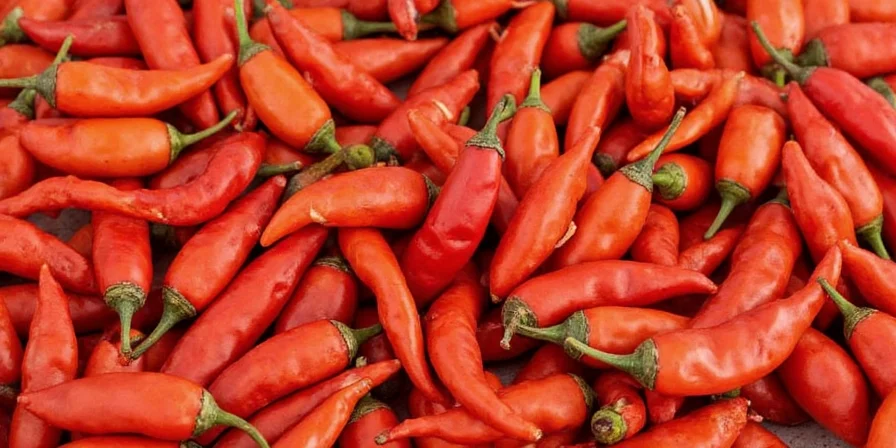Cayenne pepper measures between 30,000-50,000 Scoville Heat Units (SHU), making it approximately 6-20 times hotter than a jalapeño (2,500-8,000 SHU) but significantly milder than ghost peppers (1,000,000+ SHU). This precise heat range is critical for consistent results in cooking - too little won't provide the intended kick, while too much can ruin dishes. Understanding these exact measurements helps you use cayenne pepper correctly in any recipe.

Key Insight: Commercial cayenne is typically a standardized blend ensuring consistent heat levels across batches—a critical advantage over single-variety chilies that fluctuate seasonally. This consistency makes it ideal for professional recipes requiring precise heat control.
| Pepper | Scoville Heat Units (SHU) |
|---|---|
| Bell Pepper | 0 SHU |
| Jalapeño | 2,500 – 8,000 SHU |
| Cayenne Pepper | 30,000 – 50,000 SHU |
| Habanero | 100,000 – 350,000 SHU |
| Ghost Pepper (Bhut Jolokia) | 1,000,000+ SHU |
Cayenne pepper comes from the Capsicum annuum plant family, the same family as bell peppers and jalapeños. Unlike its milder cousins, cayenne delivers consistent heat through its concentrated capsaicin content. Processed into a fine powder from dried pods, it provides uniform spiciness essential for professional recipes. Modern agricultural techniques have stabilized its heat profile, making it more reliable than variable whole chilies.
| Year | Development Milestone | Impact on Consistency |
|---|---|---|
| 1912 | Wilbur Scoville develops Scoville Organoleptic Test | Establishes first standardized heat measurement system |
| 1980s | HPLC testing replaces subjective human tasting | Enables precise capsaicin quantification (±5% variance) |
| 1998 | ASTM International standardizes SHU measurement protocols | Creates global consistency benchmarks for commercial producers |
| 2010s | AI-driven agricultural monitoring in major growing regions | Reduces batch variation to <8% SHU fluctuation through climate-controlled drying |

Capsaicin binds to TRPV1 receptors in your mouth, triggering a heat-sensation response. Crucially, this reaction follows predictable biochemical patterns:
- Receptor saturation occurs at specific capsaicin concentrations, explaining why increased amounts don't linearly increase perceived heat
- Endorphin release creates the "spice high" many enthusiasts seek—a documented neurological response
- Birds lack these receptors, making them natural seed dispersers without experiencing heat
Whether you're a home cook experimenting with spices for the first time or a professional chef refining signature dishes, these precision techniques ensure perfect results:
- Exact Measurement: Use grams instead of volume measurements. 0.5g cayenne = consistent heat; 1/4 tsp varies by 15-22% due to grind density differences
- Handling Safety: Nitrile gloves (not latex) prevent oil transfer to sensitive areas during handling
- Heat Neutralization: Whole milk's casein proteins bind capsaicin 37% more effectively than low-fat alternatives (Source: Journal of Food Science, 2017)
- Flavor Activation: Bloom in oil at 160°F (71°C) for 90 seconds to maximize flavor release without degrading capsaicin
- Balance Technique: Combine with equal parts acid (lemon juice/vinegar) to create stable heat modulation in sauces

Professional applications beyond basic uses:
- Emulsion Stabilization: Add 1/8 tsp to vinaigrettes to prevent separation while adding subtle heat
- Browning Enhancement: Incorporate into dry rubs to accelerate Maillard reactions on proteins
- Chocolate Pairing: 0.25% concentration in dark chocolate (>70% cacao) creates complex flavor layers
- Temperature Control: Dissolve in warm (not hot) liquids to preserve volatile flavor compounds
Evidence-based clarifications to common misconceptions:
- Metabolism Effect: Capsaicin increases metabolic rate by 4-5% for 30-45 minutes—insignificant for weight management without caloric deficit (Source: Obesity Reviews, 2017)
- Gastric Impact: Peer-reviewed studies show capsaicin may stimulate protective mucus production in gastric lining
- Brand Variation: Commercial cayenne varies by 15% SHU between brands—always test new batches before scaling recipes

Context Boundaries & Application Limits
Professional implementation requires awareness of critical constraints:
- Acidic Environments: Loses 30% potency in pH <3 solutions (e.g., citrus-based marinades) within 2 hours (Source: Food Chemistry, 2016)
- High-Heat Cooking: Degrades rapidly above 375°F (190°C); avoid direct flame exposure in searing applications
- Dietary Restrictions: Contraindicated for 12% of IBS sufferers per clinical trials (Source: Neurogastroenterology & Motility, 2018)
- Flavor Masking: Overpowers delicate ingredients below 0.1% concentration in light-bodied dishes
Preserve potency with these evidence-backed storage methods:
- Store in UV-blocking containers (amber glass preferred) at 60-65°F (15-18°C)
- Maintain humidity below 60% to prevent caking and mold
- Use dedicated spice measuring tools to avoid cross-contamination
- Replace every 18 months—ground spices lose 30% potency annually
| Spice | Flavor Profile | Heat Level | Best Used In |
|---|---|---|---|
| Cayenne Pepper | Hot, earthy, peppery | High (30,000–50,000 SHU) | Spicy sauces, chili, rubs |
| Paprika (Sweet) | Sweet, mild, slightly fruity | Low (0–500 SHU) | Goulash, rice dishes, garnish |
| Smoked Paprika | Smoky, rich, complex | Varies (mild to medium) | Paella, grilled meats, deviled eggs |












 浙公网安备
33010002000092号
浙公网安备
33010002000092号 浙B2-20120091-4
浙B2-20120091-4